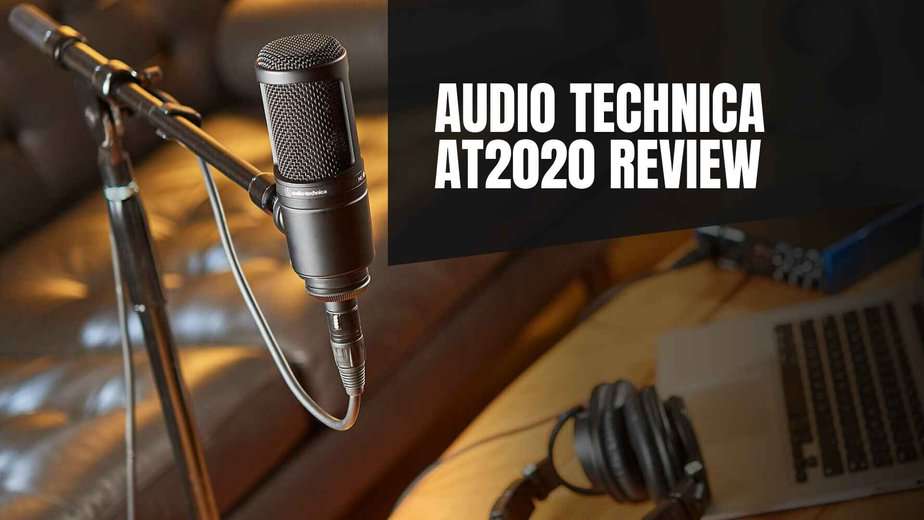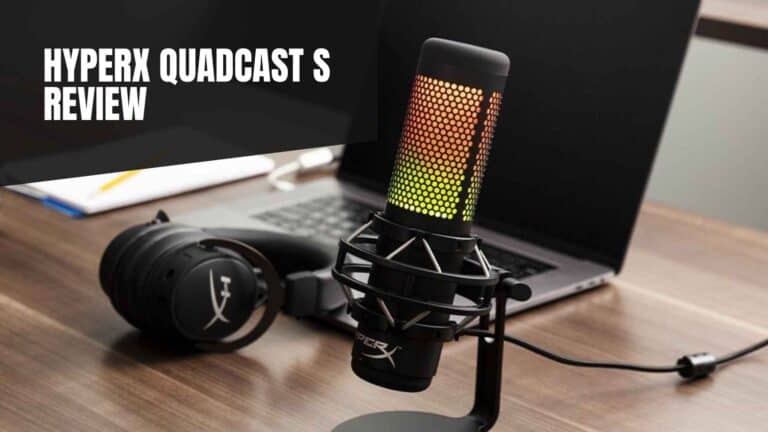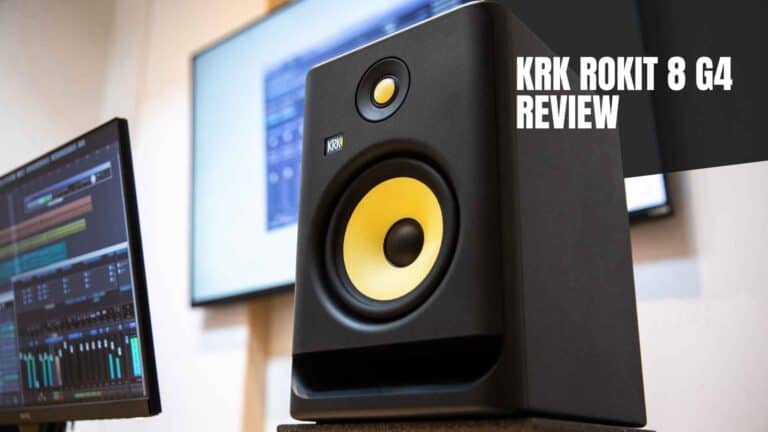Audio Technica AT2020 Review: The Most Talked About Budget Condenser Mic
Introduction

If you’re researching about your first microphone to purchase, you would likely stumble across countless reviews of the Audio Technica AT2020.
We’ll be unraveling what all the fuss is about in this Audio Technica AT2020 review, right from a brief history of the microphone to its incredible build and sound quality. We’ll also be proposing some great budget condenser mics as an alternative to the AT2020.
So let’s see what all the hype is about and whether the Audio Technica AT2020 condenser mic is worth your time!
At a Glance
The Audio Technica AT2020 is an affordable condenser XLR mic with a robust build and exceptional sound quality. It’s a mic that has become a favorite in both home studios and professional setups. The AT2020 has a natural midrange sound, the ability to handle loud sounds, and has a sleek, modern design.
However, it’s not without its drawbacks. Some users find the top end a tad harsh, and there’s noticeable self-noise when the gain is increased significantly. Additionally, the lack of microphone controls and minimal accessories might be a letdown for some.
Nonetheless, for those venturing into the audio world, the AT2020 promises a semi-professional studio-grade quality at just $99.00.
Pros
Cons
History of the AT2020

When Audio-Technica introduced the AT2020 condenser microphone as part of their 20 Series in 2004, they weren’t just launching another microphone; they were setting a new industry standard.
Priced under £100, the Audio Technica AT2020 was hailed as the first affordable studio microphone, making studio-quality sound accessible to a broader audience.
Over the years, the 20 Series expanded, introducing various models tailored to different needs, from the AT2010 cardioid condenser vocal microphone in 2007 to the AT2020 USB mic in 2018, catering to the rising demand for computer-based recording.
In 2020, Audio-Technica celebrated the AT2020’s legacy with limited edition models, and by 2021, the AT2020’s sales had surpassed a staggering one million units. This milestone was commemorated with a 24-karat gold-plated AT2020 and a generous donation to the Hungry For Music charity.
Trusted by renowned artists like Billie Eilish, who recorded her debut album “Ocean Eyes” with the microphone, the AT2020’s journey from its inception to becoming a household name in the audio industry is a testament to Audio-Technica’s commitment to delivering high-quality audio to everyone.
Design and Build Quality
The Audio Technica AT2020 is among the most iconic microphones for home studios, streamers, podcasters, and YouTubers. It stands alongside other popular microphones like the Blue Yeti and Shure SM7B.
Robust and Durable

Now, don’t let its surprisingly affordable $99.00 MSRP (manufacturer-suggested retail price) fool you. This is a solid mic that neither looks nor feels like it’s cutting corners. With its sleek, professional black all-metal body and a mesh grill that stands its ground when pressed, it’s clear that this mic means business.
In fact, the Audio Technica AT2020 shares the same top-tier build and design DNA as its upscale sibling, the AT4050, which comes with a $699.00 price tag. Kudos to Audio Technica for not skimping on quality, even for their entry-level mics!
When I first laid hands on the Audio Technica AT2020, it radiated durability and had a reassuring weight to it. It’s also not as cumbersome as the Blue Yeti, especially when you factor in the Yeti’s weighty stand.
Minimalist Design

While the Audio Technica AT2020 might sport a minimalist look with no dials, switches, or USB connection and just a straightforward XLR port at its base, it’s all by design. Therefore, you’ll need an audio interface with 48V phantom power to use this XLR mic on your computer.

However, if you don’t want the additional cost or hassle of dealing with an audio interface, you should consider getting a plug-and-play USB microphone that can be used directly with your computer and does not require phantom power.

Additionally, there’s a label reading ‘BACK’ on the rear of the microphone to ensure users don’t mistakenly speak into the wrong side, wondering why the audio sounds faint. This is a thoughtful addition, especially since the Audio Technica AT2020 has a uniform appearance from all angles.
Accessories

Despite its wallet-friendly price, the Audio Technica AT2020 comes packed with several accessories: a sturdy all-metal mount adapter and a 3/8” to 5/8” thread adapter for attaching to a mic stand or boom arm, and a chic carrying pouch to keep your mic snug and safe.
Sound Quality

Take a stroll through Audio Technica’s product page for their wired microphones, and you’ll be greeted by a bold banner proclaiming the Audio Technica AT2020 cardioid condenser microphone as ‘The Mic that Started a Revolution.’
However, they’re not just blowing their own trumpet because there’s a reason behind this audacious claim. This powerhouse of a microphone didn’t just become popular; it soared with sales numbers dancing past the one million mark in 2021.
Amidst a sea of competitors vying for the top spot over the years, Audio Technica clearly hit the right note with the Audio Technica AT2020, be it in sound quality or their branding magic.
Cardioid Polar Pattern
Like most condenser mics out there, the Audio Technica AT2020 features a cardioid polar pattern, which resembles a peach or a rounded heart shape in its diaphragm.
This means it primarily picks up sound from the front while rejecting background noise from the sides and rear.
However, it doesn’t offer the same level of isolation as dynamic microphones or the high directionality of small-diaphragm shotgun mics. There’s still some leeway even if you move slightly to the side of the mic.
Frequency Response

The Audio Technica AT2020 condenser microphone boasts a generally flat frequency response, complete with a wide bass and treble extension, and a subtle boost in the higher frequencies above 5kHz.
But beyond just analyzing frequency response graphs, the real question is: how does it sound?
The mic delivers a smooth and natural midrange with minimal coloration, making it ideal for preserving the authentic tone of voices in podcasts and voiceovers. As a sensitive mic, the Audio Technica AT2020 captures intricate details with remarkable crispness and clarity across the frequency spectrum.
While the Audio Technica AT2020 is often labeled a ‘bright’ microphone with a somewhat limited bass depth, it does enhance the crispness for those with deeper voices. However, for someone with a baritone voice like mine, it doesn’t lend the same authoritative tone that mics like the Shure SM7B and Electro-Voice RE20 would.
Additionally, while the Audio Technica AT2020 adds a certain ‘shimmer’ to treble tones, the high frequencies can occasionally sound a tad ‘harsh’ or ‘piercing’, especially around the 7kHz mark. This can contribute to listener fatigue.
Such sharpness becomes even more pronounced when belting out notes or playing higher-pitched acoustic instruments like a violin or an acoustic guitar, potentially making voices sound slightly sibilant.
But, setting aside that bright top end, the overall sound profile is well-balanced and warm. Plus, the mic impresses with its off-axis response. There’s minimal coloration when you shift your voice to the side, ensuring room reverberations don’t overly distort the recorded audio. However, venture to the rear of the microphone, and the audio begins to sound muddier.
Sensitivity
As a condenser microphone, the Audio Technica AT2020 boasts a relatively high sensitivity of 14.1 mV/Pa. A higher number indicates greater sensitivity, meaning the mic requires less gain to amplify the audio to an audible level. However, there’s a catch: a highly sensitive mic tends to pick up unwanted background noise.
For some context, consider the Shure SM7B dynamic microphone, which has a sensitivity of just 1.12 mV/Pa. This is why it demands so much gain to be heard. I’ve witnessed folks maxing out the gain on their audio interface, and sometimes, the Shure SM7B still isn’t loud enough, leading them to use a Cloudlifter to add some extra gain to it.
In contrast, with my Audio Technica AT2020, I only need to adjust the gain on my PreSonus Studio 26C audio interface to about halfway to achieve a clear and audible sound.
And thankfully, it’s not hyper-sensitive like the legendary Neumann U87 Ai, which has a pretty high sensitivity of 28 mV/Pa.
Such highly sensitive condenser microphones are designed for well-treated professional studios. Using them in an amateur home studio with subpar acoustic treatment would only capture everything from street noise to the hum of your air conditioner.
The beauty of the Audio Technica AT2020 is its balanced sensitivity. It’s versatile enough for a home studio, even one without top-tier acoustic treatment. Believe me, my room lacks any acoustic treatment, yet when recording vocals with the Audio Technica AT2020, my audio consistently sounds pretty decent!
High Sound Pressure Levels

Another great characteristic of the Audio Technica AT2020 is its high sound pressure level of 144 dB, which is comparable to a jet engine from 100 feet away!
So, unless you’re planning to record a jet plane’s takeoff, there’s no need to worry about audio distortion from loud sources like electric guitars, cymbals, or snares.
However, it’s still crucial to manage the gain stage correctly and set a gain level that doesn’t clip during the loudest parts of your song!
Problems with Self-Noise and Plosives
However, one challenge that many users, including myself, encounter with the Audio Technica AT2020 is its self-noise and its handling of plosives.
While the self-noise isn’t overwhelmingly problematic, it becomes noticeable when you increase the gain or apply excessive compression to your audio track.
Thus, this microphone might not be the top choice for content like ASMR. Expect to hear a fair amount of buzz and hisses alongside your taps, crinkles, and whispers!

I strongly recommend investing in a pop filter or windscreen for this mic, given its sensitivity to plosives. Peter Piper would surely have a bone to pick with how this mic captures those popping sounds!
And while you’re at it, considering a pop filter, it’s also wise to grab a shock mount. Without one, table bumps and knocks become all too audible, especially when using the provided microphone mount.
Alternative Mics
If you think getting an Audio Technica AT2020 is too cliché, here are some other mics that are of high-quality and priced quite similarly in this Audio Technica AT2020 review:
AKG P120
If you’re in the market for an alternative with the same price as the Audio Technica AT2020, then the AKG P120 might just be your perfect match. It could even pass as the AT2020’s twin since they both look so similar.
The AKG P120 offers a warmer and more mellow tone compared to the Audio Technica AT2020 and doesn’t come across as harsh in the higher frequencies.
What’s more, it boasts a few microphone controls absent in the Audio Technica AT2020, including a -20dB attenuation pad and a bass roll-off switch set at 300Hz.
If you are keen, you can check out our full review of the AKG P120.

Audio Technica AT2035
For just an additional $30, you can snag the Audio Technica AT2035 microphone, which offers a significant upgrade over the Audio Technica AT2020, even if it’s only considered a one-step advancement.
The AT2035 boasts a larger diaphragm size of 0.96″ (24.3mm), in contrast to the AT2020’s more modest 0.63″. This gives the AT2035 an edge with higher sensitivity and a flatter frequency response, enabling it to capture sounds with enhanced accuracy and detail.
The superior sound quality alone could justify its slightly higher price tag. But the perks don’t end there. The AT2035 is also equipped with a switchable 80Hz high-pass filter and a -10 dB attenuation pad.
And as the cherry on top, Audio Technica generously includes a sturdy shock mount in the package.

AKG P220
The AKG P220 is to the AKG P120 what the Audio Technica AT2035 is to the AT2020: a one-step upgrade. Priced at $159.00, it’s a tad more expensive than the AT2035, but it compensates by including a metal carrying case, a feature absent in the AT2035.
Boasting a larger 1″ diaphragm compared to the AKG P120, the P220 promises superior audio quality. And for added value, it comes with a shock mount. Like the AKG P120, it’s equipped with a -20dB pad and a 300Hz bass roll-off switch.

Final Verdict

The Audio Technica AT2020 has certainly earned its reputation as a game-changer in the world of budget condenser microphones.
From its robust build to its impressive sound quality, it’s clear why this mic has become a staple in professional and home studio setups alike. Its rich history, marked by milestones and endorsements from renowned artists, speaks volumes about its reliability and performance.
While it’s not without its quirks, like the self-noise and plosive handling, the Audio Technica AT2020 offers incredible value for its price point. However, be sure to get a pop filter and a shock mount to deal with those bumps and plosives!
If you’re a budding podcaster, a musician looking to record vocals or acoustic guitar, or a gaming streamer, the AT2020 is a good starter mic.
The Audio Technica AT2020 delivers studio-grade quality without breaking the bank, making it a top choice for those looking to get the best bang for their buck. If you’re just starting out in audio, you can confidently purchase this mic, knowing that it has been tried and tested by more than a million users before you.
Production Information
Specifications
- Microphone Type: Condenser
- Polar Pattern: Cardioid
- Diaphragm Size: 0.63″ (16mm)
- Power Requirements: 48V phantom power
- Frequency Response: 20 Hz to 20,000 Hz
- Sensitivity: -37 dBV/Pa (14.1 mV/Pa) @1kHz
- Max SPL: 144 dB
- Self Noise: 20dB (A-weighted)
- Output Connection: XLR
- Weight: 345g (0.76 lbs)
- Accessories: Mount adapter and carrying pouch
Features
- High SPL and wide dynamic range
- Threaded mic stand mount and carrying pouch provided

Audio Technica AT2020










